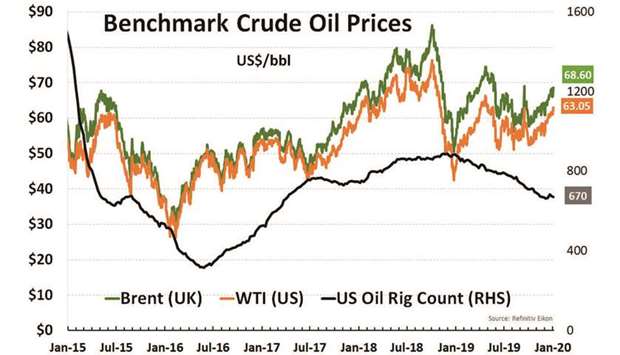Oil
Oil prices jumped to the highest level in more than three months on Friday after the US killed a top Iranian military commander in Iraq, sparking fears that escalating conflict in the region could disrupt global oil supplies. An air strike at Baghdad airport killed Major-General Qassem Soleimani, architect of Iran’s spreading military influence in the Middle East, prompting Iran’s supreme leader, Ayatollah Ali Khamenei, to vow revenge.
Brent crude ended the session up 3.6% at $68.60 a barrel, off the session peak of $69.50, the highest level since the mid-September attack on Saudi oil facilities. West Texas Intermediate (WTI) crude settled up 3.1% at $63.05 a barrel. The session high was $64.09 a barrel, its highest since April 2019.
Tensions between the US and Iran have flared over the past year as Washington re-imposed sanctions on Tehran and in the aftermath of a missile and drone attack on oil installations of the Saudi Aramco company for which US officials blamed Iran. The Soleimani killing has brought those tensions back to the forefront, fanning worries about a squeeze on crude supplies, though the effect of the increased geopolitical risk remains unclear.
The US embassy in Baghdad on Friday urged all citizens to depart Iraq immediately, and dozens of US citizens working for foreign oil companies in the Iraqi oil city of Basra were preparing to leave. However, according to Iraq’s Oil Ministry, all oil fields were operating normally and production and exports were not affected. Still, the oil futures market is already beginning to price in near-term supply tightness. Oil prices also found support after US crude stockpiles fell by the most since June.
Gas
Asian spot prices for LNG were little changed last week amid quiet trade and low liquidity. The average LNG price for February delivery into northeast Asia was estimated at around $5.10-$5.20 per million British thermal units. Demand remained weak following the Christmas and New Year holidays with plenty of supply.
A new gas transit deal struck between Russia and Ukraine last month, which will see a new route for Moscow to supply Europe for at least another five years, has eased market concern about gas supply disruptions. Asian prices have reacted to a drop in European gas prices in December partly in response to the new deal.
Last month, US legislation to impose sanctions on firms laying pipe for Nord Stream 2, which aims to double gas capacity along the northern Nord Stream pipeline route to Germany prompted concerns about delays to that new gas supply. The gas flows were scheduled to start up in the first half of 2020. Also, in Europe, northwest terminal LNG send-out is still strong and gas storage levels robust but analysts say LNG send-out could decline over the next week or so.
In Asia, warmer-than-normal weather is forecast to continue in Japan and South Korea for the next ten days, while China will also experience higher-than-normal temperatures, which could depress demand for gas for heating. US LNG exporters had a record year in 2019 with exports up by more than 60%, but prices are seen remaining low in 2020, according to analysts, as another warm winter in Asia will cut heating demand and prompt Asian importers to divert cargoes to Europe.
n This article was supplied by the Abdullah bin Hamad Al-Attiyah International Foundation for Energy and Sustainable Development.

.
